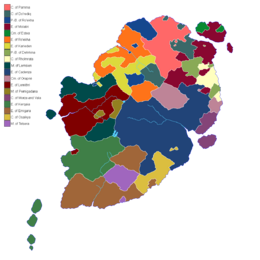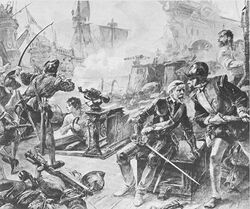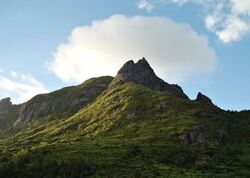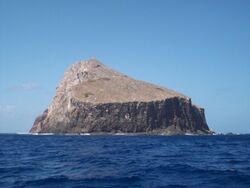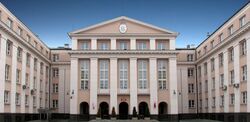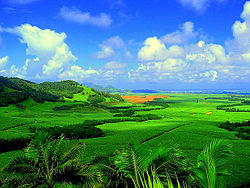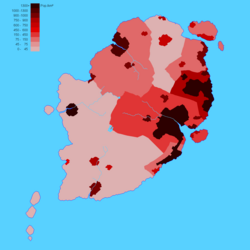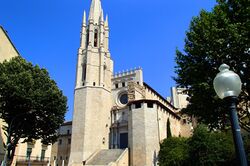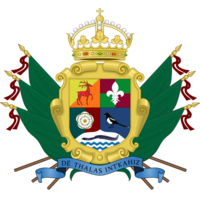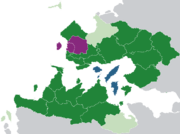Cadenza: Difference between revisions
m (Size!) |
m (1 revision imported) |
Revision as of 18:34, 28 January 2019
Cadenzan Duchy Berent Khadeg | |
|---|---|
| Motto: Dë Thalas int'Kahiz (Khadenz) "Ancient Guardian of the Seas" | |
| Anthem: March of the Cadenzan Fusiliers | |
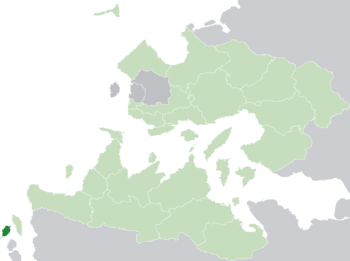 Location of Cadenza (dark green) in the Trellinese Empire (light green) | |
| Capital and largest city | Cadenza |
| Official languages | Khadenz, Trellinese |
| Ethnic groups (2013) | 78.3% Khadenzi 7.2% Trellinese 14.5% others |
| Demonym(s) | Cadenzan |
| Government | Unitary oligarchic constitutional republic |
• Beriq | Adrahil Kamënus |
• Chairman of the Greater Council | Vilaum Tolyxa |
• Protector | Azara V |
| Legislature | Joint Councils |
| Earls' Council of the Republic | |
| Greater Council of the Republic | |
| Establishment | |
• Settlement | 54 BC |
• Maritime Republic | 712 |
• Third Constitution | 1795 |
• Client of the Trellinese Empire | 1871 |
• Acquired Protectorate status | 1964 |
| Area | |
• Total | 5,183.94 km2 (2,001.53 sq mi) |
• Water (%) | 0.52 |
| Population | |
• 2016 census | 1,506,583 |
• Density | 290.63/km2 (752.7/sq mi) |
| GDP (PPP) | 2012 estimate |
• Total | $108.490 billion |
• Per capita | $76,349 |
| GDP (nominal) | 2012 estimate |
• Total | $117.288 billion |
• Per capita | $82,541 |
| Gini (2012) | 28.9 low |
| HDI (2011) | 0.901 very high |
| Currency | Tezahr (Ŧ) (KHT) |
| Time zone | UTC−2 (WTT) |
| Date format | dd/mm/yyyy |
| Driving side | left |
| Calling code | +543 |
| Internet TLD | .kh |
Cadenza (pronounced /kɑːˈdɛnzɑː/; Khadenz: Khade), officially the Cadenzan Duchy or Cadenzan Republic (Khadenz: Berent Khadeg or Tezhron Khadeg) and colloquially the Protectorate of Cadenza, is a sovereign island nation and protectorate of Trellin in western Astyria. The city of Cadenza, on the southern coast, is the capital and largest city. Cadenza is an island country lying wholly in the Sea of Jajich. Its one major island and eight surrounding islands comprise the Trellinese Empire's westernmost archipelago, the Eth Khadeg. The nearest landmasses to Cadenza are Aurelia to its south-east and the Trellinese protectorate of Kur'zhet to its east. Cadenza maintains two overseas dependencies: the island of Torim Viqalka 1700 km to the south and the coastal enclave of Laeryt in western Azmir, in southern Trellin.
Cadenza was first settled by waves of Ethlorek migrations beginning in 54 BC. Culturally and ethnically related to the populations of nearby Kur'zhet and Azmir, this early period of settlement was relatively peaceful as the small population spread out over the entire island in a number of autonomous towns. Christianity, arriving from Hesperidesia, became the majority religion by 85 AD. From the sixth up to the early eighth century, the rulers of the island's oldest and largest settlement worked to consolidate power over the entire island and by 714 had united the various city states into one republic. The Merchant Republic of Khade and its neighbour, Kur'zhet, spent much of the eleventh to early fourteenth centuries locked in a contest for domination of the region's western routes, with Cadenza ultimately emerging victorious, unhindered in its mercantilist aspirations. In the fourteenth century it became a close ally of the Trellinese Empire, ushering in an era of unmatched prosperity and colonial ambition which would lead to a long-running attempt to colonise and conquer the people of Azmir.
In the mid-seventeenth century, a period of Trellinese isolationism had disastrous consequences for the now over-reliant Cadenzan economy, and the government of the small republic was forced to shift its focus further afield with the colonisation of Insula Fera, an expedition which would hold severe backlash for the Cadenzan government, and Kamalbia, then a nominal territory of the Exponential Empire. The only lasting territorial acquisition from these endeavours were the island of Torim Viqalka and Laeryt, a coastal exclave in Azmir. When Trellin finally exited isolation in 1844, Cadenza immediately applied to become a client state, acceding in 1871, putting it once more in a position to manage and exploit sea trade into Trellin from the south and east. This became particularly important to the nation's economy when Trellin reentered isolation in 1913, as Cadenza became one of a tiny minority of imperial ports able to conduct trade both inside of the empire and out. Cadenza went on to become a protectorate of the Trellinese Empire in 1964.
Despite its small size, the modern Cadenzan economy is one of the most affluent and most globalised in Astyria, with a strong focus on its financial sector and other major tertiary industries. It has in recent years made a name for itself as a hub of regional banking and trade, with policies heavily oriented towards drawing in international businesses. The country has been branded by economists as the 'Cadenzan Economic Free Zone', referencing its low tax rates and the extensive support to foreign firms offered by its Board of Commerce.
The country is governed as a constitutional republic with an elected duke, known in Khadenza as a Beriq, as its head of state. Cadenza has an open borders policy and is generally regarded as one of the freest countries in Astyria. It is a member of the Ethlorek Community, a protectorate of the Trellinese Empire and a signatory of the Tel Al-Riyah Pact and also holds a council seat in the E10 Council of Nations.
Name
The name "Cadenza" was first applied to the city which is now the capital of the Cadenzan state. When it was first settled, this town was known as Khadezha Iniza, meaning "Town on Khade". Khade itself was, and is, the name of the island and the state in the native language. In Latin, the island was known as Cadda. Two main theories predominate on the origin of the name Cadenza for the country. One holds that the contracted name for the capital, Khadenza, became applied to the entire country as the city-state grew in power. The other argues that the Latin word Caddensis, meaning "of Khade", was incorrectly interpreted as deriving from a name Caddensa. A similar, alternative theory suggests a contraction of Cadda insula, meaning "Khade island", to Caddinsula. In this theory, -ula would have been taken as the diminutive suffix, meaning "Little Caddinsa", distinguishing the island from the larger Kur'zhet. It has also been suggested that the name originates in the words for the Cadenzan language or people (Khadenz and Khadenzi, respectively).
History
Early history
Cadenza has been continuously inhabited since 54 BC, when it was first colonised by an Ethlorek people closely related to the Trellinese and possessing a similar language. Christianity arrived in the archipelago in about 70 AD, before it reached the rest of Trellin, brought by Roman refugees from Hesperidesia, who called the island Cadda in Latin. Christianity became the majority religion by 85 AD. The interplay between Christianity and native Thaerinism led to a crusading environment as local earls and earl-bishops vied for power on the island or provoked religious wars in Kur'zhet and Azmir, while Cadenzan missionaries such as Saint Misrav attempted to spread Christianity eastward.
Cadenza nevertheless held a relatively minor role in west Astyrian politics until around 700 AD, when its position on one of the great sea routes gave it a key role in trade. Over the next century, some of the larger earldoms began uniting the disparate states on the island. In 712 the earldom of Cadenza, in the southeast, instituted a maritime republic including neighbouring Emigara and several other statelets, using its preeminence on the new trade routes to assert its hegemony over the entire island.
Development of a Maritime Republic
Because of its location between nascent empires such as Exponent and Nikolia, Cadenza prospered as a venue for traders. A series of statutes illustrate the protections given to foreign traders in Cadenza. From the early 10th century onwards, Cadenzan merchants became locked in an enduring and often bitter rivalry with those from Kur'zhet, with each would regularly sponsoring privateers to harass its rivals. This situation became so well known in Astyria that, by 1250, these privateer fleets matched those of either nation. After Cadenza's and Kur'zhet's privateers launched a concerted raid in 1287 on the port city of Canve, both states recognised the danger they posed and drove the pirates out, signing a treaty to end the use of privateers in their rivalry. Nevertheless, this was not the end of the two duchies' wars, as the Kurzheti Crusades continued into the 1300s.
From the late 1100s, the missionary efforts of the Siresian Order brought Cadenza and the Knights of Saint Misrav into conflict with the nascent Margraviate of Azmir, an ally of Kur'zhet and a staunchly Thaerine state. This conflict simmered at a low level for the better part of a century, but as the ongoing Kur'zheti crusades sapped the Knights' manpower their fortress at Tyarz was left vulnerable. It was seized in 1301, precipitating the lengthy and brutal Azmiri Crusade, which lasted until 1344. In the aftermath, Cadenza was left with a number of fragmented holdings in Azmir which it would struggle to retain over the next two hundred years. Of these, only the enclave of Laeryt remains today.
The prosperous Maritime Republic came under the gaze of imperialist Trellinese monarchs in the fourteenth century and only avoided an invasion by the diplomatic manoeuvring of its dukes, who built their arguments on the historical ties of Cadenzan missionary work and on contemporary trade. Instead of facing military subjugation, Cadenza acquired a favoured position as an ally of the Trellinese Empire and saw the importance of its ports grow further. Trade with Trellin flourished, and Cadenzan ports became increasingly dependent on their role as links between Trellin and west Astyria.
When Trellin entered isolation in 1603, the resulting sharp fall in trade severely harmed the Cadenzan economy. Attempts to reorient led to a disastrous expedition to the Insula Fera as the Merchant Republic, unfamiliar with east Astyrian politics, was quickly driven out of the Mare Ferum. Cadenza spent the next decade gathering information on the east through privateers, who primarily carried out raids on convoys of Exponential ships. In 1614, a fleet under the ducal flag attacked Portus Regalis, then the capital of the Scottopian Isles, and burned the city. A brutal conflict against the Empire of Exponent, the War of the Magpie and the Dragon, followed immediately. Defeated and forced to sue for peace, Cadenza was made to pay extensive reparations to Exponent, in exchange for which it received control over southern Kamalbia. When diamonds were discovered there in 1622, it brought in a steady flow of wealth to the impoverished republic.
Cadenza continued to make attempts to expand its empire throughout the seventeenth century, establishing strategic colonies such as Axio and Elagesk, in modern-day Kelonna, fighting a series of wars with Kelonna to secure them. As it expanded its sphere of influence the republic found itself regularly competing with Kur'zheti expeditions, and the War of 1635 saw intense conflict between the two islands. In 1641, conspirators from Kur'zhet and within the Cadenzan government set fires which caused tremendous destruction in the centre of the capital. In following years, the city along the banks of the Temloth was largely rebuilt with wider, straighter roads and grander buildings, many of which remain today.
Membership of the Trellinese Empire

Following another, brief period of Trellinese isolationism, which ended in 1844, Cadenza petitioned the Sidereal Crown to enter the Empire as a client state, though it was not until 1871 that the operative details were ironed out and Cadenza acceded. As a client state, Cadenza was guaranteed its economic ties with Trellin in the event of further isolationism, which was not to come until 1913. Before this, Trellin became embroiled in a bloody civil war in which Cadenza nominally sided with the royalist faction, though its contribution was limited to blockades on the ports of Durats, Khem and Txakla. When the Empire returned to isolation in 1913, Cadenza remained open, adopting a role as representative of Trellin's commercial interests abroad and acting as a gateway, along with Kur'zhet and Arimathea, for imports and exports.
Geography
Cadenza is the ninth largest island in Trellin, and the smallest of the three autonomous protectorates of the Trellinese Empire, with a land area of 4,763.11 square kilometres. Lying just over five hundred kilometres south of the equator, it experiences a perennial tropical climate while remaining free of the tropical storms that plague the Sea of Jajich. Its 411 kilometre long coastline consists mainly of sandy beaches or low cliffs, with several sheltered harbours. It is ringed by eight smaller islands, together with which it forms the Eth Khadeg, the Cadenzan Archipelago. These islands have a total land area of 188.29 square kilometres. Its two overseas territories, Laeryt and Torim Viqalka, are 1.67 and 0.74 square kilometres, respectively.
The island is divided roughly equally into north and south by its two main rivers, the Temloth and Karea, which have their sources within four kilometres of each other. The other rivers on the island are the Berak, flowing southward through Emigar, and the Osia, which enters the sea at Roe'kha.
Most population centres are on the island of Cadenza, with the exception of north Canve which lies on the island of Edarak. Every town larger than 20,000 is within two kilometres of the coast, with the interior of the island being mountainous or rain forest. The rugged summits are the only parts of the mountains not heavily forested, and it is an area popular with hikers and hill-walkers, particularly the peak of Vekh Neramë. The lower slopes of the mountains are gentle and fertile, ideal for various kinds of cultivation and agriculture, particularly in the west. In the east, the flat land between the mountains and the seas has been extensively developed by the rapid urbanisation of the capital and its satellite towns, though substantial areas remain used in the cultivation of sugarcane. All the major towns are linked by a comprehensive motorway network which rings the island.
The geology of the archipelago is very stable, its bedrock being ancient granite. The most common rock types are igneous, laid down when the islands were volcanically formed, though the west has some notable limestone outcrops. The southern island arc is formed mainly from coral, with reefs of outstanding biodiversity being visible all around the Eth Khadeg. In recent years strict measures have been put in place to control pollution and damage to the reefs, with substantial reef growth in 2012-2013 proving the success of these efforts.
Climate
| Port of Cadenza | ||||||||||||||||||||||||||||||||||||||||||||||||||||||||||||
|---|---|---|---|---|---|---|---|---|---|---|---|---|---|---|---|---|---|---|---|---|---|---|---|---|---|---|---|---|---|---|---|---|---|---|---|---|---|---|---|---|---|---|---|---|---|---|---|---|---|---|---|---|---|---|---|---|---|---|---|---|
| Climate chart (explanation) | ||||||||||||||||||||||||||||||||||||||||||||||||||||||||||||
| ||||||||||||||||||||||||||||||||||||||||||||||||||||||||||||
| ||||||||||||||||||||||||||||||||||||||||||||||||||||||||||||
Cadenza experiences an equatorial tropical rainforest climate, narrowly avoiding the monsoon rains that affect most of Trellin's coastline on the Sea of Jajich. The weather station at the Port of Cadenza records an average of 1,450 mm annually, compared to the empire's average of roughly 1200 mm.
The prevailing winds are west-northwesterly, but a strong southeasterly air stream from mainland Trellin generally disrupts this current before it reaches Cadenza and protects the island from most major storms. Nevertheless, hurricanes occasionally sweep the northern coast, and in 2008 severe weather caused substantial damage to Ro'ekha and Canve.
Cadenza receives very little temperature variation during the course of the year, with an annual average range of just 6 degrees Celsius. The average highs vary by only 4 degrees, while the lowest temperatures tend to be from June to August. This situation has been brought about by Cadenza's equatorial position and the almost constant ocean temperatures around it. This extreme climatic stability has also led to a flourishing marine ecosystem and abundant coral reefs surrounding the archipelago.
Politics
Cadenza is a unitary constitutional republic with a presidential system of government. The Joint Councils form the state's bicameral legislature with two houses: the Ladron Kerepin Tezhroni or Earl's Council of the Republic, a body composed of the Cadenzan hereditary Kerepi (earls), and the Ladron Serë Tezhroni or Greater Council of the Republic, whose members represent local constituencies. The Government Chambers are the meeting place of both houses of government as well as the location of the Duke's offices.
The Beriq, or Duke, serves as head of state, is elected for a five-year term and may be re-elected twice. He is traditionally elected by the Kerepi from among their number in secret ballot. He holds the power of veto over all new legislation. Adrahil Kamënus assumed the position on 19 April 2011. The positions of the Kerepi are hereditary titles of nobility. Their status derives from charters granted to towns and villages of Cadenza. There are currently eleven Kerepi, the most recent addition to their number being the Kerep of Mefra, elected by the people in 1981.
The head of government is the Chairman of the Greater Council, and is appointed by the Duke on the nomination of the council.
Local government
Government is organised at a local level, with the nation being divided into eleven earldoms or kerepaqen. Each kerepaqa is administrated by an elected council, whose chairman - the earl, or kerep - possesses the only tie-breaking vote. These councils also serve as advisory councils for the kerepi, who also form the upper house of the legislature and in turn advise the duke.
Law
Cadenza has a civil law legal system with a written constitution that provides for a parliamentary democracy. The court system includes the Supreme and Constitutional Court, the Court of Appeals, the High Court and the Magistrates' Court. Until 2007, all but the local Magistrates' courts resided in the Judicial Palace in the capital, but with the exception of the Supreme and Constitutional Court have moved to newer facilities nearby.
The National Constabulary is the state's civilian police force, headed by a government-appointed Commissioner. The force is responsible for all aspects of civil policing, both in terms of territory and infrastructure. Though its members do not normally routinely carry firearms, instead being limited to batons and pepper spray, the Constabulary's Armed Support Unit are commissioned to carry firearms.
Foreign affairs
As a constituent nation of the Trellinese Empire, Cadenza's foreign policy is influenced heavily by the Sidereal Crown, which in no small part directs Cadenzan policy, particularly in relation to treaties and bi- or multilateral arrangements. Until early 2014, when the empire officially exited isolation, Cadenza was one of the three protectorates which acted to maintain its interests in Astyria and to act as a liaison between the empire and other states. It became a member of the Ethlorek Community in 1953.
Cadenza is one of the most diplomatically active nations in the Trellinese Empire, being a Council Member of the E10 Council of Nations and a signatory of the Tel al-Riyah Pact. It maintains a neutral, pacifist stance in most situations, with its current geopolitical doctrine heavily centred around the promotion of regional stability through international trade.
Military
With its defensive needs legally provided for by the Armed Forces of the Sidereal Crown, Cadenza maintains only a token military, possessing no air force and only a small army. Its six-vessel navy is among the most modern in Astyria, though it only consists of corvettes, frigates and destroyers; it is however a major point of national pride that Cadenza maintains a navy, and its vessels are regularly seen in allied ports in western Astyria and assisting in anti-piracy and operations and interdiction throughout the Sea of Jajich.
Economy
Services
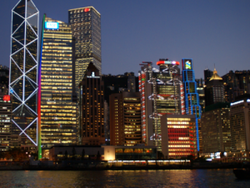
The economy of Cadenza is one of the most prosperous in Astyria, heavily focused on its service industries having in recent years come to be one of the region's leading financial locations. The capital is host to the Astyrian Financial Centre, a compact waterfront district of skyscrapers that houses the headquarters of numerous international banking corporations, including Bank of Yohannes' Astyrian headquarters and the domestic Cadenza Financial. This emphasis on the tertiary sector emerged as the national economic strategy in response to ongoing economic depression in the capital and nationwide.
In the north of the country, the main service industries are primarily tourist-based rather than financial. The town of Ro'ekha in particular hosts large communities of foreign for retirees and boasts a strong food retail sector as well as leisure activities such as hiking and pleasure cruises. The town of Lema is a media centre, home to domestic film studios and and news outlets such as the Lema Examiner.
Industry and agriculture
The island's south-east has seen rapid urbanisation as a direct result of its economic expansion, with a thriving construction industry in Cadenza, Temir and Mefra. The country does not have any other substantial secondary sector, with the exception of the food processing and packing industries based in Emigar in the south-west. This major transit point for the island's agricultural output holds a key position for Trellinese foreign trade. Otherwise, Cadenza's exporting secondary industries have been largely abandoned due to being outperformed by those of Kur'zhet.
Despite a shift from primary to secondary and tertiary industries since the late 1980s, much of Cadenza's flat land remains cultivated for commercial agriculture. The south and west of the country are primarily given over to grain production, especially wheat.
Transport
The island has two international airports, at Cadenza and Lema, which serve many routes to the rest of Astyria and several further destinations with scheduled flights. Cadenza Airport is the hub of Air Khade, the country's flag carrier. Domestic and regional routes are also served by Ro'ekha Airport, with regular flights to western Trellin. A private airfield at Temir serves chartered flights to the city from throughout the region.
All of the country's roads and motorways are owned and maintained by the government through Efaekh ti'Laumarü Khadeg (the Cadenzan Travel Authority). Cadenza is served by a modern motorway network which connects all of the island's major cities. Two main routes, the C1 and C2, effectively ring the island, with the C3 completing a smaller circle in the north. The C4, completed and opened in 2015, follows the coastal route from Cadenza to Emigar and thus includes the young city of Mefra in the network.
Road transport has mostly superseded the use of railways in Cadenza, though much of the comprehensive infrastructure laid down in the mid-1930s remains in place and is still owned by Arnach Sereg Khadeg (the Great Cadenzan Railway). The island of Edarak, in Canve, makes extensive use of trams for transport on its steep hillside. Plans to introduce trams to the cities of Cadenza and Temir were put on hold in 2009 but were not officially shelved.
Though largely eclipsed by the ports in Kur'zhet, the Port of Cadenza remains a major ferry port with routes from as far afield as the Aurora and Blackhelm Confederacies. It is also a crucial point of distribution for trade from and into western Trellin, as most ports were not authorised to carry out international trade until early 2014. A consequence of this is that the Port of Emigar is one of the busiest grain exporting ports in Astyria. The properties of the Port of Cadenza include 36 berths and over 350 hectares of waterfront.
Demographics
The islands of Cadenza were unpopulated before its settlement in the first century BC by Ethlorek migrants from eastern Lorecia. In the 2016 Census of Astyria, Cadenza's population was 1,506,583. This was an increase of just over 6% on the 2013 population of 1,420,971, which was in turn an increase of 6.4% since 2008. Current population projections estimate a national population over 1.6 million by 2020. The majority of people in the country are of Khadenzi descent, comprising some 78.3% of the population. This represents a massive shift in the last thirty years alone, when compared with a 94% Khadenzi population in the 1980 census. The dominant minorities are ethnic Trellinese and Kur'zheti, representing over half of the foreign population in Cadenza between them. The large growth in minority populations has been attributed to the increasing economic globalisation of the protectorate of Cadenza, as its prosperity draws in international business.
Population distribution
Cadenza is one of the most urbanised countries in Astyria, with almost 800,000 people - over half the population of the state, 1.5 million - living in its seven largest urban areas. The overall urban population accounts for just under 89% of the total. The major metropolitan areas are, in order of size, Cadenza, Temir, Ro'ekha, Mefra, Canve, Lema and Emigar. 96% of the population lives within 20 kilometres of the sea. The preponderance of Cadenza's population is on the country's east coast, concentrated in the metropolitan areas of Cadenza, Temir and Mefra, which together account for nearly two thirds of the population of the state.
The island's interior, primarily mountainous, is very sparsely populated. Intensive agriculture and market gardening in the southwest have meant there is little space for organised settlement in the area outside of the towns of Emigar and Lema. The three southwestern earldoms - Emigara, Ker'qaved and Lemithri - have average population densities between 30 and 80 per square kilometre, in contrast to the population density of Tevro, 1,250 per square kilometre. Lema is the notable exception in the southwest as being more densely populated than all but a handful of towns in the state.
The relatively populous earldom of Roakkon is divided from the principal population centres by neighbouring Pammez, where strict zoning regulations and environmental protections, in addition to the presence of rugged upland in the south of the earldom, have maintained one of the lowest population densities in Cadenza.
Cadenza's two overseas territories are both densely populated. The islet of Torim Viqalka, with a population of over 1,500, has a population density of two thousand per square kilometre. The city-enclave of Laeryt has a population density of nearly 6,600 per square kilometre, with almost eleven thousand people within its borders.
Largest cities or towns in Cadenza
Statistical, Demographical and Census Department | |||||||||
|---|---|---|---|---|---|---|---|---|---|
| Rank | Earldom | Pop. | |||||||
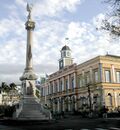 City of Cadenza  Temir |
1 | City of Cadenza | Khadeg | 304,629 |  Ro'ekha  Mefra | ||||
| 2 | Temir | Tevro | 229,868 | ||||||
| 3 | Ro'ekha | Roakkon | 74,130 | ||||||
| 4 | Mefra | Mefrika | 63,219 | ||||||
| 5 | Canve | Molatiri | 43,908 | ||||||
| 6 | Lema | Lemithri | 38,862 | ||||||
| 7 | Emigar | Emigara | 25,519 | ||||||
| 8 | Do'rediq | Pammez | 18,748 | ||||||
| 9 | Vedkathna | Kerqa'ved | 13,378 | ||||||
| 10 | Laeryt | Laeroni | 10,957 | ||||||
Language
The official and most commonly spoken languages are Khadenz and Trellinese, both of which are Ethlorek languages. Khadenz developed out of Old Trellinese, the language spoken by the first settlers of Cadenza in the first century BC. Modern Trellinese, however, did not arrive on the island aside from trade contacts until about the 14th century and was not widely spoken until the 1800s when the country began to move towards integration with the Trellinese Empire. The two languages remain generally mutually intelligible, which has kept popular adoption of Trellinese relatively low.
Most ethnic minorities in Cadenza have retained their own languages, and the island has a great linguistic diversity as a result. English is increasingly used on the island as the language of trade, but it has not overtaken either Khadenz or Trellinese, both of which are protected under the constitution as the official languages of the state, and the government has taken measures to maintain the dominant position of the Ethlorek languages on the island.
Education
Cadenza has a highly ranked educational system, with several of its higher level institutions being ranked in the upper tiers of world universities. It includes the multifaculty Imperial College of Ro'ekha and Cadenza City University as well as the specialist Temir College of Economics. The country's research institutions are also well known within their fields, with the Cadenzan Meteorological Institute in particular being a world leader in meteorology and climatology studies.
Religion
Freedom of religion or irreligion is guaranteed by the Cadenzan constitution. The dominant religion is Ladath Thaerinë, with 52.1% of the population, which evolved from the belief system brought by the original Ethlorek settlers and was standardised to conform with the religion of the Empire through its interactions during the late 13th century. In the 1980 census it was the faith claimed by 68.4% of the population.
The number of Roman Catholics in Cadenza has risen sharply in recent decades with the arrival of foreign ethnic groups, increasing from 24.6% of the population in 1980 to 35.8% in 2013. Historically, Cadenza was the first part of Trellin to receive Christian missionaries, but the number of Christians declined during the country's colonial era as many of them went to Cadenza's overseas trading posts. The entire country falls within the Archdiocese of Khade, the episcopal seat of which is the Cathedral of Saint Misrav and the Martyrs.
Culture
Drama
During the late imperial era of Cadenza, the country became well-known throughout western Astyria for its playwrights whose works were performed throughout the Ethlorek world. The most famous Cadenzan theatre company was the Ro'ekhan Dramatic Society, and the wealth its Astyrian tours earned it was used to build the Grand Auditorium, now a major music venue in Ro'ekha.
Music
Music is a central part of Cadenzan culture, with major venues in each city for live performances. The Royal Concert Hall of Cadenza, in the capital, regularly hosts international acts, especially as part of the Cadenzan Festival of Culture. In summer 2014, the capital was named the honorary inaugural Astyrian Capital of Culture.
Society
Cadenzan society tends to be quite conservative, influenced in no small part by its highly religious population. The constitution mandates a degree of secularisation, removing the state entirely from marriage while recognising it as a religious institution. Referenda on instituting any kind of civil union have failed on several occasions.
Sport
Popular sports in Cadenza include sailing, swimming, horse-riding and football. The national football team has achieved success in the Ethlorek Cup and Astyrian Cup of Nations.


